-
TrackoBit
Manage commercial vehicles with the new-age Fleet Management Software
TrackoBit -
TrackoField
Streamline your scattered workforce with Field Force Management Software
TrackoField -
Features Resources
-
Blog
Carefully curated articles to update you on industrial trends. -
White Paper
Insightful papers and analysis on essential subject matters. -
Glossary
Explore an alphabetical list of relevant industry terms. -
What’s New
Get TrackoBit & TrackoField monthly updates here. -
Case Study
Explore the cases we solved with our diverse solutions. -
Comparisons
Compare platforms, features, and pricing to find your best fit.
-
About Us
Get to know TrackoBit: our team, ethos, values, and vision. -
Careers
Join the most dynamic cult of coders, creatives and changemakers. -
Tech Support
Learn about our technical support team and services in detail. -
Events
Check out the exhibitions where we left our marks and conquered. -
Contact Us
Connect with us and let us know how we can be of service.
How to Build a Sales Process? A Comprehensive Guide
- Author:Shivani Singh
- Read Time:14 min
- Published:
- Last Update: May 16, 2025
Table of Contents
Toggle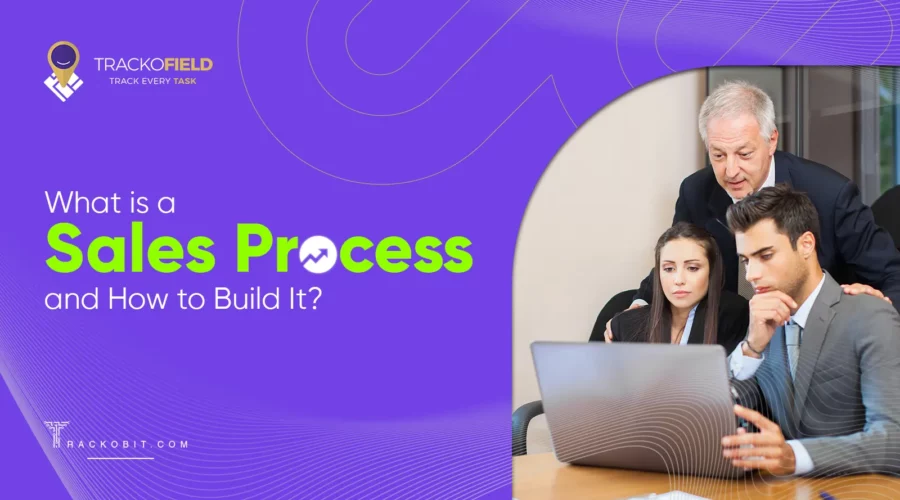
Wondering what a sales process is and how to create one? This guide will turn your queries into actionable answers, leading you to address challenges and close more leads.
Table of Contents
Toggle
Navigating field sales without a solid sales process is like trying to sail through stormy seas without a map. A well-structured sales process serves as your compass, guiding your sales reps. to win more client meetings, follow-ups, and new opportunities to close deals.
It provides the roadmap required to sell with precision. Even if your sales are performing well, implementing a defined sales process can elevate your business to new heights. You can turn obstacles and challenges into stepping stones, setting your team up for success.
Keep reading further if you wonder, “How do I create a winning sales process? Why haven’t I emphasized it in the first place? or how can I ensure my team follows it?”
What is a Sales Process?
Often referred to as a sales cycle, a sales process is defined as a complete series of steps that sales reps must take to turn prospects into customers. It entails every part of the customer journey, from first prospect to post-purchase nurturing.
Each stage of the sales process provides direction, helping maintain sales momentum. A standardized sales process also makes it easier to identify bottlenecks and address them in real time, ultimately leading to more sales.
For instance – It can involve sending MR sales representatives to meet potential clients, pitch the new medicine batch, follow up, and close the leads with orders.
Read Blog – How does an MR reporting software work?
The Stages of the Sales Process – from Prospecting to Following Up
A sales process typically includes a series of stages depending on the sale’s complexity. It outlines the key tasks and milestones the team must achieve to resolve the challenges of a sales process and generate more qualified leads.
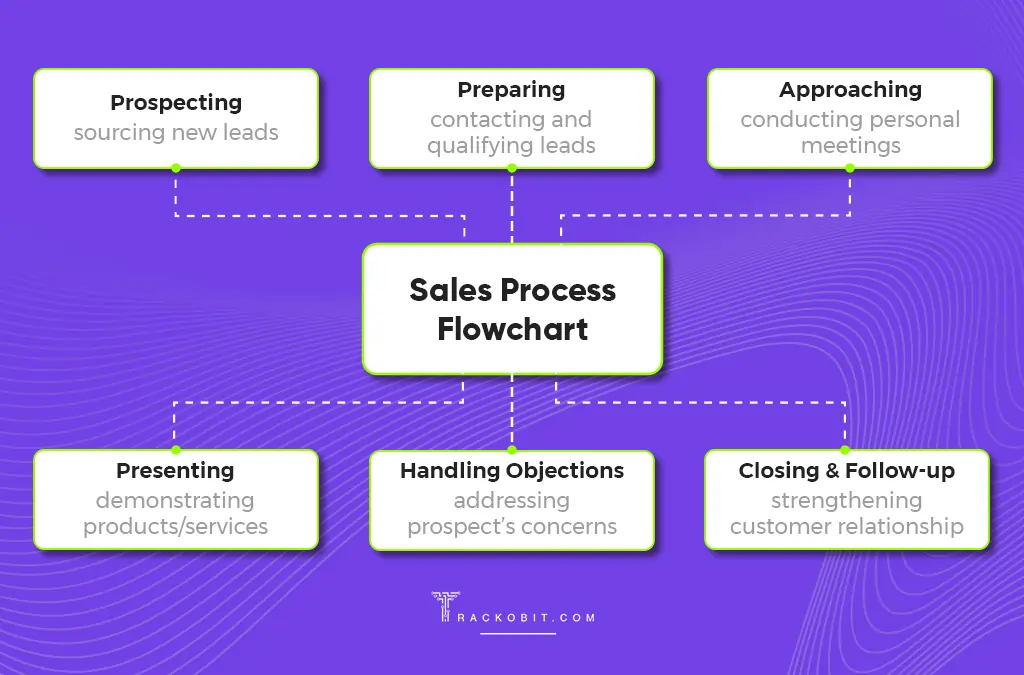
Sales Process Flowchart
1. Prospect
Prospecting is the first stage, focusing on identifying new and early opportunities to initiate the sales process. It is a crucial step that must be included in the daily or weekly routines of sales reps.
The specific activities, strategies, and methods used in prospecting can vary across sales organizations. However, some common prospecting techniques include:
The activities and strategies given inside “prospecting” can differ from organization to organization. However, some prominent prospecting are:
- Cold calling,
- Cold emailing,
- In-person networking,
- And online research on sites like Linkedin and Quora
This stage is all about reaching out and connecting with potential prospects who are a good fit for your product. By engaging in these activities, you can identify promising prospects and develop buyer persona – profiles that outline the characteristics of companies most likely to get your product.
Read these examples to know the tasks provided within the “prospecting” stage
|
2. Prepare
The preparation stage typically involves two key steps– connecting and qualifying leads. The “connect” step is all about making sales reps engage with early-stage prospects to collect more information.
Next, the team moves on to qualifying these leads– determining if they are worth the time and effort for sales engagement. For this, reps generally conduct connect or discovery calls, asking questions like:
- “What is your role within your company?”
- “What are your day-to-day responsibilities?”
- “What problems do you want to resolve?”
- “Why is this a priority for your business?”
- “What other solutions are you considering?”
Additionally, build a trusted LinkedIn profile to demonstrate your strong social presence in the industry. Frequently post, comment on others’ posts, and connect with the prospects.

Almost 82% of sales managers and reps believe relationships are crucial in selling. This helps them identify whether the prospect has a genuine need for the product.
| HOT TIP
Use the BANT – Budget, Authority, Need, Timeline, for a more structured and effective way to effectively evaluate whether you are talking to the right person. |
3. Approach
At this time or during the approach stage, you will make your first personal connection with your prospect. As this step involves one-on-one meetings, ensure to ask such questions that get the client involved in the conversation.
For instance, if you’re a pharma sales executive in a one-on-one meeting, you might ask:
- What do you need to enhance patient care or manage treatment?
- Are there any problems and issues you are facing with your existing treatment protocols?
- What benefits do you want to have from our new pharmaceutical solution?”
Additionally, offer discounts or samples of drugs and medicines to let prospects experience the benefits firsthand. This not only helps you identify pharma sales team challenges but also builds confidence in your product.
4. Presentation
With the foundation steps behind you, it’s essential to advance to the presentation stage. This phase typically involves a detailed product or service demonstration and is positioned as the fourth stage in the sales process due to its time-intensive nature.
By considering the prospect’s unique needs, you can customize your presentation, effectively, positioning your product as the solution to their specific challenges. This tailored approach not only highlights how your offerings meet their needs but also deepens your connection with the prospect.
Furthermore, this step allows you to apply all your research in a way that directly addresses the customers’ concerns and aspirations.
| Pro Tip
Incorporate a mix of product demonstrations, tours, video presentations, and other interactive elements into your presentation. Also, stress to add a personalized touch, emphasizing how your solution is relevant to the prospect’s pain points. |
5. Handling Objections
This stage can be a major hurdle where salespeople drop out of the process like:
- 44% give up after the first rejection.
- 22% after the second
- 14% after the third
- 12% after the fourth
This highlights the importance of handling objections, as 80% of sales require at least five follow-ups to successfully close. So, you should see this as an opportunity to refine your pitch and address any emerging concerns.
To do this effectively, you and your team need to be well-versed in your product and adept at resolving issues as they arise. If someone is not efficient enough to handle objections, then you must recognize them by analyzing their productivity with the help of field sales employee tracking software.
Regardless of the objection, it is crucial to actively listen, emphasize their concerns, ask insightful follow-up questions, and provide vital proof that demonstrates your solution’s effectiveness.
For instance, if a customer says they cannot invest till next month, you could offer them discounts, additional savings, or special promotions. Besides, remind them of the potential cost of missing out if they decide to forgo the purchase completely.
6. Closing
As you reach the closing stage, it’s time to finalize the deal. This may involve drafting a proposal, negotiating terms or pricing, signing contracts, processing payments, or even addressing any last-minute concerns.
It’s essential to ensure that the buyer is fully aware of the terms and conditions of the contract. Additionally, you can use upselling techniques to offer additional products that enhance their initial purchase.
Once the deal is successfully closed, the salesperson gets a commission based on the amount paid by the prospects, reinforcing motivation throughout the organization.
| Pro Tip:
After completing the translation, always thank the customer and maintain the relationship– don’t cut ties immediately. Also, leverage software like TrackoField to streamline order placement and management. It automates order placement, digitizes documentation procedures, and saves both your business’s and your prospect’s time. |
7. Follow-up
The sales process should not end with closing the deal to but goes beyond to nurturing the customer relationship. Effective and constructive follow-ups strengthen these connections, increasing customer satisfaction and loyalty.
During the follow-up stage, you might send a thank you note or make a call to understand their experience with your products or services. You can encourage them to share feedback, ratings, and reviews on your social media platforms
Additionally, follow-up often involves finalizing logistical aspects of the sale, such as arranging deliveries, installing products, or signing additional contracts. A well-executed follow-up not only enhances customer satisfaction but also opens doors for repeat sales and referrals, which can attract new customers. Consider after sales service automation to stimulate the winnings associated with the follow-up stage.
| Beyond defining the stages of your sales process, it’s crucial to track and monitor your field sales’ productivity during meetings and product demonstrations.
How TrackoField Helps TrackoField provides instant updates on rep’s location, task status, and availability in real time. It also lets you learn when a rep starts or ends a task, ensuring you have up-to-date information on their activities. Moreover, it equips your sales teams with an advanced order management system that helps them take the orders, and get approval on them immediately. The software also features a geofencing capability, creating virtual boundaries around specific task sites. This feature enables you to monitor when reps enter or exit these locations, providing a clear picture of their working hours. Thus, letting you improve the accuracy of productivity assessment. Moreover, TrackoField’s shift scheduling feature allows you to efficiently prepare job schedules and assign warm leads to sales reps in advance. This proactive approach ensures that your sales reps are engaged early in the process and increases the likelihood of closing a deal. |
How To Improve Your Sales Process and Close More Leads
Enhancing your sales process can significantly boost interaction between your organization and customers. Here are some effective practices for you to take into consideration:
1. Analyze your existing sales process
Get insight, evaluate, and decide
Don’t proceed without insight, assess your current sales process and identify areas for improvement. Consider your sales reps’ experiences – what’s working and what isn’t to tailor the process.
Identify gaps and inefficiencies
Also, look for gaps and inefficiencies by examining your rep’s performance. Field sales tracking software like TrackoField provides target vs. achievement reports, letting you assess how many deals were closed compared to targets. Its time tracking feature also reveals how long each stage of the process took, from start to finish.
Outline deal timelines
Based on your analysis, you need to provide a timeframe for each deal. For example, if six deals closed over six weeks, the stages might break down as follows:
- One week for consideration before signing (closing step)
- Three to five follow-up emails and calls (handling objection step)
- One demo (presentation step)
- One call and two to three emails (approach step)
- One discovery call (connecting step)
- Two emails and three calls (prospecting step)
Understand pain points and motivations
Besides, you can delve into the subtle challenges and motivations that led each deal to close. This insight helps you improve your sales approach in a way that ensures fruitful outcomes.
2. Outline the buyer’s journey
Understanding the buyer’s journey is vital as it’s only through which you can refine your sales strategy and improve customer acquisition. Here is how what you can do to outline this journey:
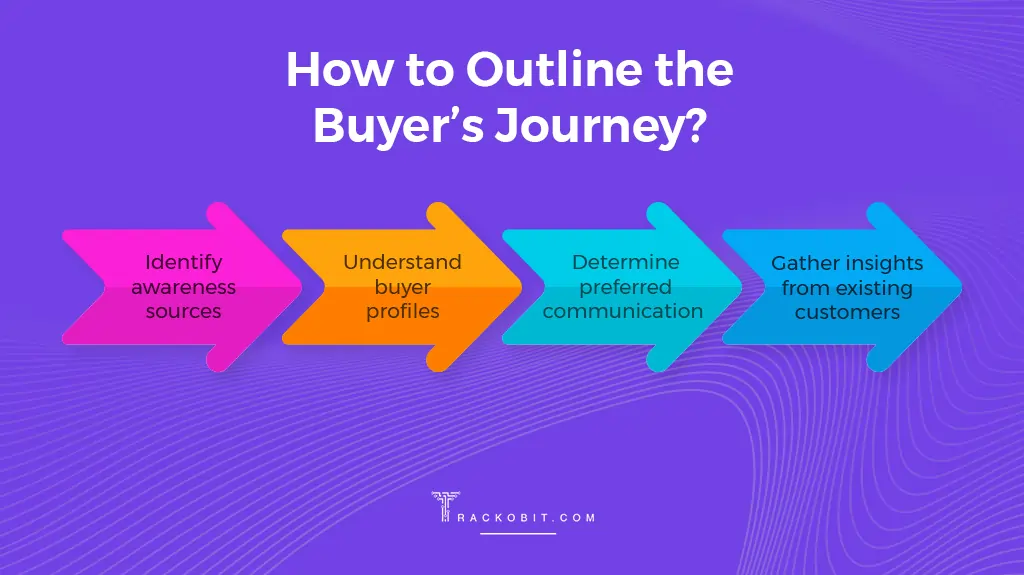
Outline the buyer’s journey
Identify awareness sources
Start by identifying how your ideal buyers must discover your services. Then, analyze marketing analytics to track all leads progress through the buyer’s journey. This will reveal which traffic sources and marketing campaigns are most effective, as well as which web pages attract the most visits.
Understand buyer profiles
Knowing where your buyers come from, their industry, and why they might be interested in your solution helps you create a more targeted sales process. This insight allows you to make appropriate changes in your strategies to better meet buyers’ needs and preferences.
Determine preferred communication methods
Gain a clearer understanding of how buyers prefer to be contacted. Learn which messages resonate with them, the common pain points they experience, and the objections they often raise. This will enable you to communicate more effectively and address their concerns proactively.
Gather insights from existing customers
Conduct surveys with current customers to uncover the rationale behind their purchase decisions and any challenges they faced during the buying process. This feedback can let you highlight friction points, helping in the refinement of your sales strategy.
By outlining the buyer’s journey, you can better optimize the sales process with customer needs, enhancing both acquisition and retention.
3. Define Prospect’s Action
A sales process acts like a series of steps that lets your prospects take specific actions to move forward. For your sales process to be smooth and effective, you need to know exactly what those actions are.
Pro Tip: Ask yourself these questions to figure out what triggers a prospect to advance:
- During the product demo, were there any features that excited the prospect and made them more interested, or any concern that slowed things down?
- When the field sales rep made their pitch, did the prospect immediately agree? If so, what led to that quick decision? What steps did the rep take to build up to that moment?
By asking and getting answers to such questions, you can fine-tune your sales process to be more predictable and effective.
4. Set clear criteria for moving forward
This step is about making sure everyone on your sales team knows exactly what to do when they signal a prospect is ready to advance. For instance, during the “presenting” step, your sales rep might share content like customer testimonials to help prospects move closer to a purchase.
Consider the following questions to ensure your team is consistent and professional at every stage:
- What do your reps need to learn about your brand and product before getting in contact with a prospect?
- What actions should your team initiate at different stages of the sales process?
- How should they handle different types of conversations with prospects?
- From videos, case studies, testimonials, blogs, etc., which kind of content should be shown to prospects at different stages of the sales process.
Setting this criterion helps your team provide a consistent and effective experience to each prospect.
5. Measure sales process results
It’s crucial whether your sales strategies and improvements are yielding results and if your team’s efforts are helping you effectively reach the target audience.
To do this, utilize advanced field sales monitoring software with robust capabilities for tracking KPIs and metrics for field service business. Having these KPIs in front lets you plan and execute your strategies more effectively.
Here are
- The average time each sales rep takes to complete their specific responsibilities at each stage.
- Total duration required for a sales executive to climb from one stage to another.
- Percentage of all sales reps who have successfully closed deals.
- Percentage of customers who request a demo after a discovery call.
You can track and analyze these metrics by generating reports on TrackoField, providing valuable insights to refine your sales approach.
Why Should You Build a Sales Process?
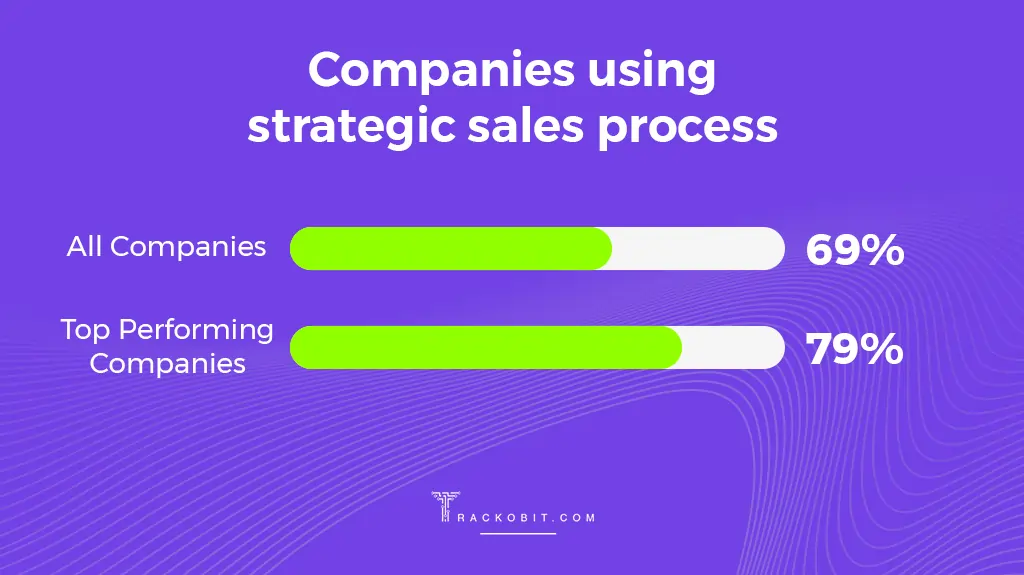
Companies using strategic sales process
Struggling to close deals despite a steady flow of leads? Without a solid sales process, missed opportunities and inconsistent results would go nowhere. This is why you need to guide every lead smoothly from start to finish with a sales process.
1. Improved Efficiency
A clear sales classifies the customer journey into well-defined stages with specific actions. This is how it enables your team to navigate each step efficiently. This structured approach reduces missed opportunities and streamlines progress toward closing deals.
2. Enhanced data-driven Insights
An efficient sales process goes beyond specifying sales stages. It provides insights into each stage, letting you pinpoint factors that lead to improved team performance. Therein, you reveal which specific actions are effective or need adjustment, thus focussing on strategies that refine your approach.
3. More Qualified Leads
What if you filter out low-potential leads and identify prospects who are most likely to become your customers? You will utilize your time to increase lifetime customer value. Well, that’s what the effective sales process empowers you with. It mitigates the efforts wasted on opportunities that are unlikely to close, helping you attract more qualified leads.
4. Predictable Revenue Generation
Establishing a solid sales process helps in closely monitoring prospects in your pipeline. This visibility provides insight into potential future revenue, making planning and forecasting more seamless. Thus, letting you evaluate how much revenue you’ll ultimately generate is easier.
5. Better Customer Experience
The sales process reflects the steps the customer takes to travel across the buying process. It incorporates each step to generate trust and offer value, laying the foundation for a positive customer experience.
In a Nutshell!
A well-defined sales process ensures that leads are closed more efficiently, but building one from scratch can be challenging. That’s where you need a transparent sales process driven by sales reps, providing you with a clear roadmap to success.
To ensure you’re on the right track, monitor every move that your field sales executives make with the right software. Why not try TrackoField? It empowers you with live workforce monitoring, a data-driven dashboard, ad-hoc task allocation, and seamless order placement. Thus, letting you ensure that your team travels through the sales process to close leads and achieve targets.
More Related Reads:
- Field Sales vs Outdoor Sales vs D2D Sales – How do they Differ?
- Employee Performance Review – What is it & Why it matters?
- 7 Payroll Challenges You Have Been Struggling With
FAQs on How to Build a Sales Process
-
What is a sales process?
A sales process is a workflow that each sales rep must follow to close more leads, acquire customer acquisition, and improve retention rates. It is also referred to as a guide for salespeople, letting them move a deal through the sales pipeline and close it.
-
How to create a sales process?
While creating a sales process, you must ensure to clear your goals, establish a conversion funnel, define an action for each stage, and measure results with metrics.
-
What is the difference between sales process vs. sales methodology?
While sales processes represent the steps taken by employees to convert an inquiry into lead, sales methodologies are defined as the ways teams can move toward the sales process.
-
What are the stages of a sales process?
A standardized sales process usually consists of 7 stages– prospect, prepare, approach, presentation, handling objections, closing, and follow-up.
-
What is the role of sales process mapping?
Mapping your sales process is important to make the sales process less abstract and easier to follow. It consists of various formats and structures and varies from one organization to another. For instance, one organization can cover the lead qualification process– whereas others might want to get a more holistic overview of the process.
Shivani is a Content Specialist working for TrackoField. She comes with years of experience writing, editing and reviewing content for software products. Her underlining expertise in SaaS especially H... Read More
Related Blogs
-

How MFIs Are Working In Modern Day Scenario? A Complete Breakdown
Mudit Chhikara December 30, 2025How field force automation is helping MFIs transform field operations.
-

Unified Field Workforce Dashboard: Monitor Tasks, Attendance & More In One Place
Mudit Chhikara December 15, 2025Bring full clarity to field operations with a single, real-time field workforce dashboard.
-
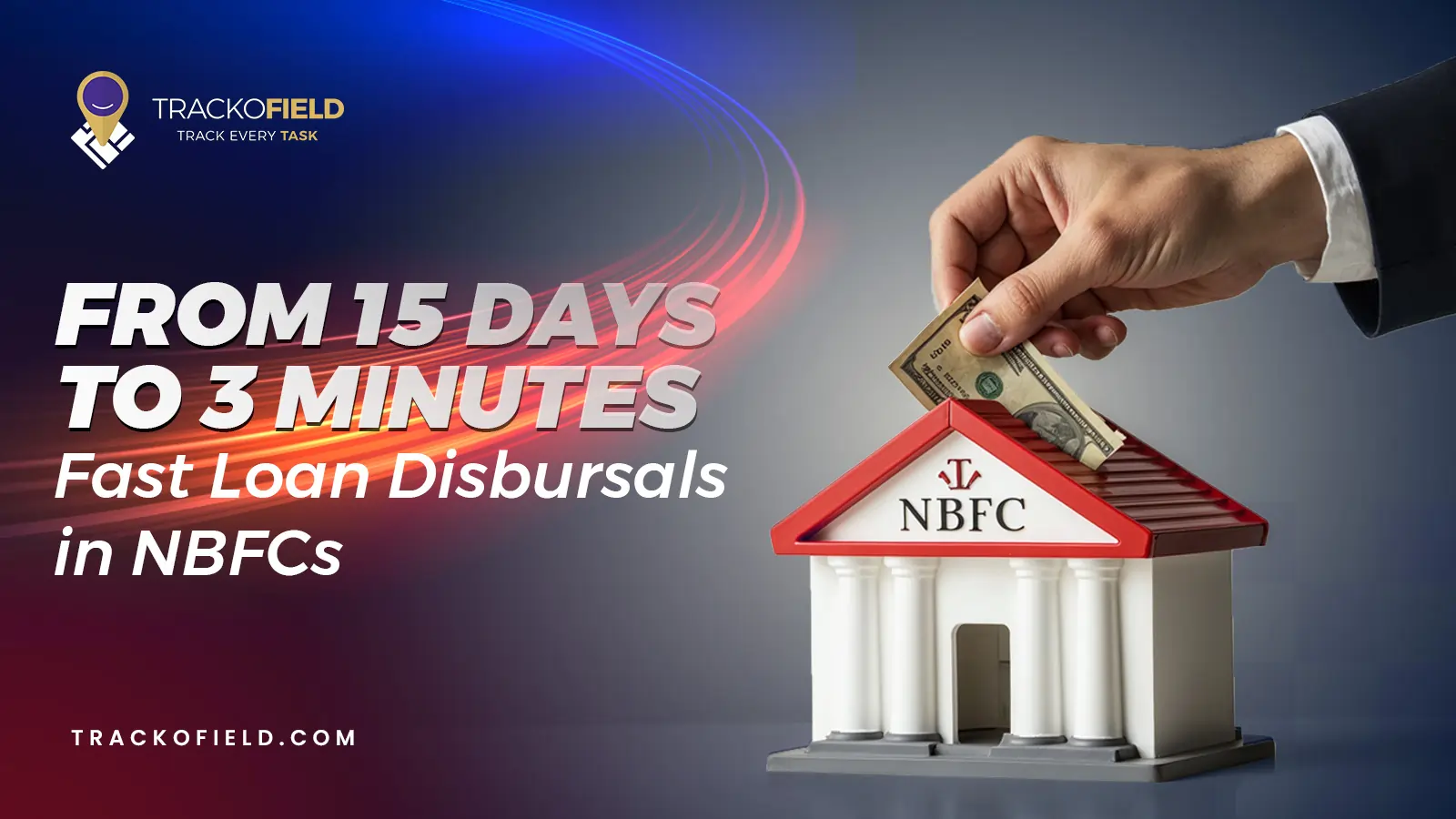
Loan Disbursement in NBFCs: From 15 Days to 3 Minutes – Learn How
Shemanti Ghosh December 11, 2025TrackoField’s AI-enabled field force automation software speeds up loan disbursals in NBFC with field agent task monitoring and facial attendance…
-

AI Facial Recognition Attendance: A Game-Changer for Fraud-Free Field Operations
Mudit Chhikara December 9, 2025Ensure transparent attendance and eliminate fraud before it even starts with AI facial recognition and geofencing.

Subscribe for weekly strategies to boost field team productivity.
Your inbox awaits a welcome email. Stay tuned for the latest blog updates & expert insights.
"While you're here, dive into some more reads or grab quick bites from our social platforms!"Stay Updated on tech, telematics and mobility. Don't miss out on the latest in the industry.
We use cookies to enhance and personalize your browsing experience. By continuing to use our website, you agree to our Privacy Policy.


































